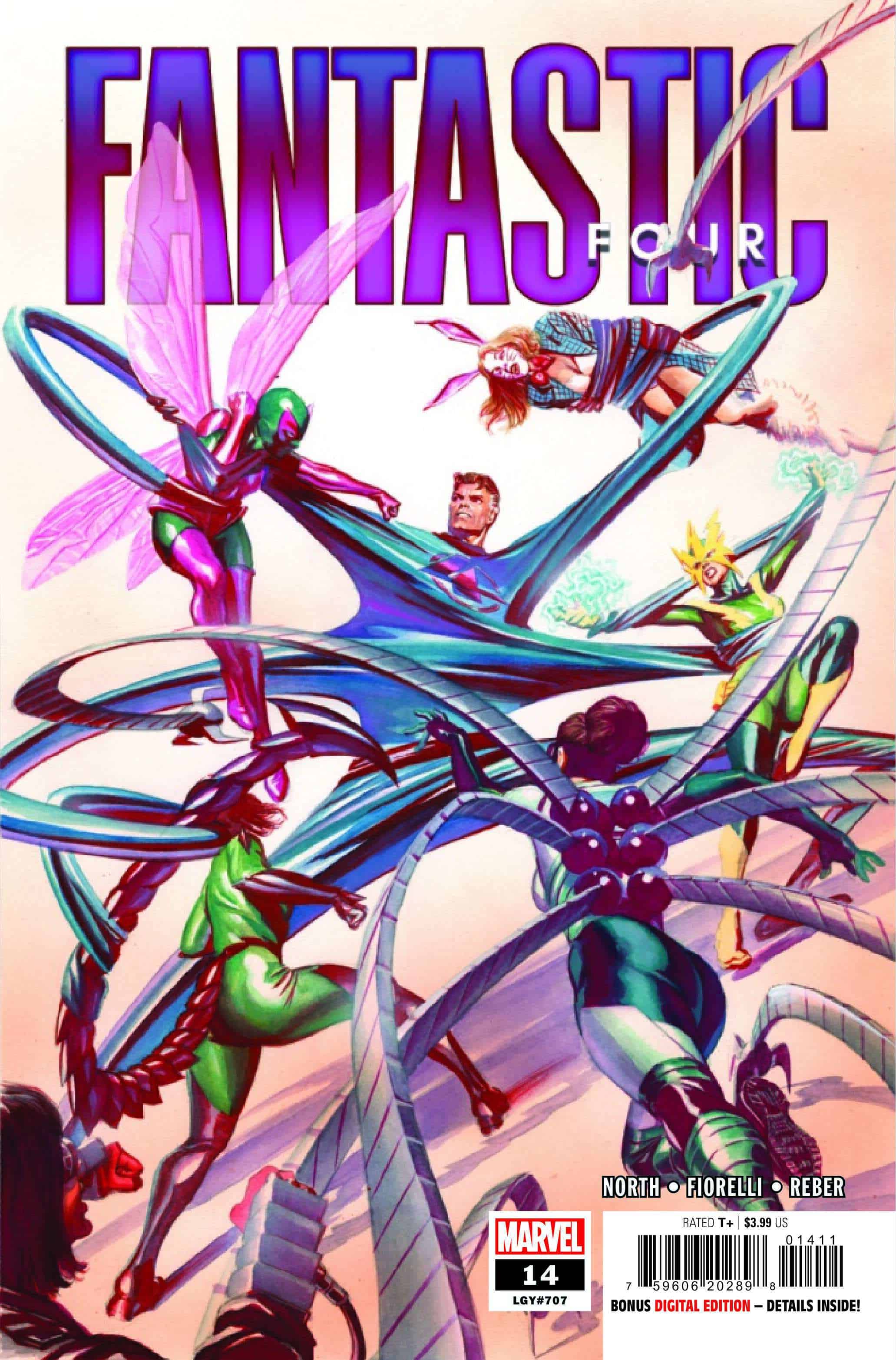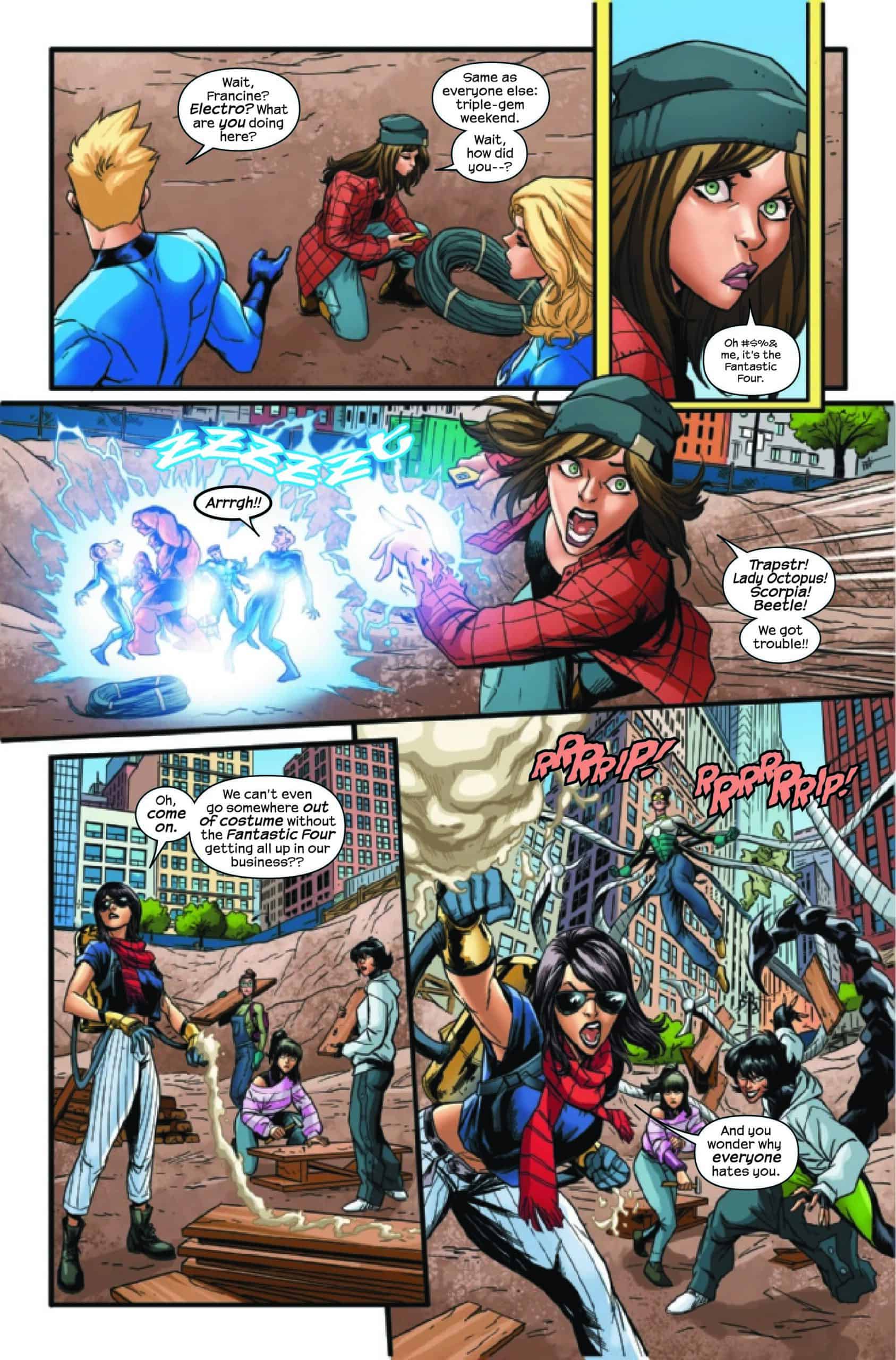Fantastic Four #14

Recap
A year ago, Reed Richards sent a whole city block the Baxter Building stands on - along with his own children and the children of his best friends Ben and Alicia - a year ahead in time. It was a desperate measure, but it saved them. And now, it's time for them all to come back. But when the Fantastic Four arrive in NYC, they find something is being built in the pit where the block once stood - and worse, nobody seems to know exactly what it is or why they're building it.
Review
Making the bad guy a billionaire is low hanging fruit these days. And for a series that’s been as clever as this iteration of Fantastic Four, it’s surprisingly on the nose. But after a couple Isaac Asimov name drops, a crash course on psychohistory, and a little Chaos Theory for dummies, we find that Fantastic Four #14 is anything but “on the nose.”
The Baxter Building is coming back to New York in Fantastic Four #14, and the team is back in the city to meet it. But to their dismay, someone is building a transmitter of unknown properties right where the building is going to materialize. The work is being organized by an app called Metamind, a mobile game that gives rewards for real life activities. Trapster, Lady Octopus, Scorpia, and Beetle–the Syndicate–are among the workers, and a quick fight breaks out. But the larger problem is Metamind and its inventor, billionaire Dan Passi, who is secretly using Metamind to manipulate the world in something akin to a controlled Butterfly Effect.
Fantastic Four #14 presents another high concept, science based plot–in this case one that relies on the Butterfly Effect as a foundation for the bad guy’s activities. It’s worth pointing out that the general public’s understanding of the Butterfly Effect is almost the exact opposite of the theory that the metaphor was coined to describe. Without getting too complex, the original use of the example (the butterfly in Brazil causing the tornado in Texas) was in the case of long-term weather forecasting and meant to explain that the impact of small, non-linear events on a system couldn’t be tracked and thus long-term prediction was nearly impossible. And with that the field of mathematics called Chaos Theory was born.
One might ask: “Why is all of this information in a comic book review?” To emphasize North’s strength in this issue.
North gets as close to the accurate description of the Butterfly Effect as one is likely to find in science fiction (and uses plot technology to avoid the “near impossible” part of Chaos Theory). Rather than simply tossing out the term Butterfly Effect and offering a two line simplistic explanation for what it is, North writes a four page conversation that goes into considerable detail about how the issue’s bad guy Dan Passi is predicting the future, why he’s doing it, and what is making it work. Fantastic Four continues to fearlessly introduce potentially new and complicated concepts and ask readers to pay close attention. It’s a huge reason that the series stands out.
That said, Fantastic Four isn’t a science picture book. This is a fun and very balanced issue. It’s surprisingly fast paced for as verbose as it is. The team’s fight with the Syndicate adds a few pages of action and humor early in the issue. There’s never any attempt to use this as misdirection away from Fantastic Four #14’s actual villain. Instead, it’s a pleasant diversion that’s fun for the reader and helps balance the issue’s overall pacing which is about to slow down for the Butterfly Effect scene before picking back up in the final pages.
Despite the disturbingly selfish work Passi is undertaking, he is a surprisingly likable character for much of the issue. It’s entirely a result of Fiorelli who produces a character who is almost constantly smiling and very affable right out of the gate. That veneer slips in a panel or two as Reed presses Passi. But the character never feels as bad as he definitely is. And even when events risk spiraling out of control and Passi has to swallow his pride and ask for help, Fiorelli never draws him in a way that’s pathetic or even pitiable in a way that has a negative connotation.
Fiorelli’s work on Passi also highlights how very minor changes can completely change the way a character is perceived. As Passi discovers that Metamind is no longer entirely in his control, he turns to Reed for help. This exchange happens over two panels. In the first, from a point of view far enough back that Reed’s face is in near-profile on one side and Passi’s is entirely in view on the other, Passi looks angry. The following panel is a close-up on Passi in which he looks more pleading. Passi looks nearly identical in each panel. The shift in emotion is the result of very minor differences.
Arched eyebrows, a smooth forehead with a crinkled nose, and a solid line defining his bottom lip all combine to make Passi assertive. He’s in charge and angry at being threatened. But round out Passi’s eyebrows, uncrinkle his nose and add a wrinkle to his forehead, and curve the line beneath his bottom lip–suddenly that assertiveness and strength is gone. He’s almost pleading.
Reber’s coloring further enhances this change. In the first panel, the difference in light and dark shading on Passi’s cheek is ever so slightly more pronounced and the darker shading is more angular. The character appears to have stronger cheekbones. In the second panel the soft and light shading blends into each other without the angular look. It further reinforces Passi’ loss of power in that moment.
It’s a fast, two panel sequence, but it marks an easy to interpret and immediate change to the character’s disposition.
Caramagna’s work in this series is seldom flashy. North’s scripts don’t often call for a lot of sound effects, and rarely is there extreme emphasis used in the dialogue. Caramagna’s talent is largely apparent in how he is able to organize dialogue, both working around the art and keeping it flowing for the reader. Fantastic Four is a verbose series, and this issue is up there as one of the wordiest.
None of the pages here ever feel overloaded with dialogue bubbles, though. Fiorelli doesn’t overload the panels with art, so Caramagna usually has comparatively empty space to play with. But even when he’s forced to push a little closer to more focal sections of the panel, his work never feels intrusive nor does the panel look overly busy.
Final Thoughts
It’s hard to argue that Fantastic Four is one of the smartest (the smartest?) comics on the shelves. Certainly North’s scripts delve into the straight up “fantastic” at times. But most of the issues are rooted in real concepts that can be explained and extrapolated from. Combine that with top notch art, and almost every month is a winner–which is exactly the case with Fantastic Four #14.
Fantastic Four #14: Butterflies
- Writing - 10/1010/10
- Storyline - 10/1010/10
- Art - 9/109/10
- Color - 9/109/10
- Cover Art - 8.5/108.5/10





